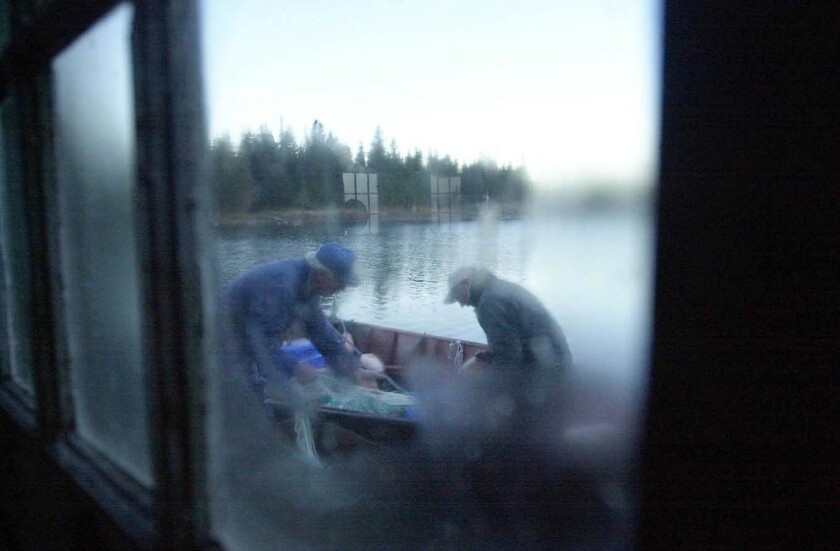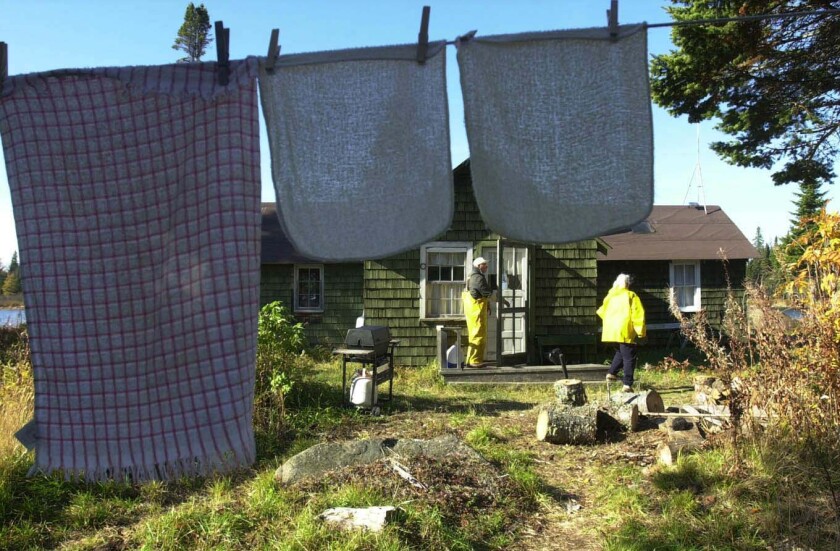ISLE ROYALE NATIONAL PARK — The 22-foot skiff bobs like a cork as Enar Strom and Milford Johnson ride the unforgiving surface of Lake Superior.
The two fishermen sway as Milford pulls in the net and Enar uncoils a lake trout, this one weighing almost 20 pounds.
The catch this mid-October afternoon isn't as big as they'd like — about 250 pounds of lake trout, whitefish and herring.
"We've been moving around trying to find where they are,'' Enar says. "We haven't been too lucky.''
Every October, Enar and Milford set nets on the southwestern tip of Isle Royale to exercise the fishing rights held by Milford's family. For a brief time they restore a way of life that is disappearing. Anachronisms in the 21st century, they are the last commercial fishermen on Isle Royale.
ADVERTISEMENT
Enar and Milford are linked to waves of Scandinavian immigrants who voyaged to America in the late 1800s to seek its "golden streets,'' or, in this case, fish-filled waters.
For the fishing families who settled on Isle Royale — the Sivertsons, Johnsons, Mattsons, Holtes, Rudes and Andersons — the archipelago became a way of life.
This group of islands, its centerpiece an 8-by-45-mile dagger of rock jutting out of Lake Superior's vast blue, became a remote fishing and mining outpost in the burgeoning Great Lakes shipping trade of a century ago.
"This place was really something in the '30s,'' Milford says. "Back in (Washington Harbor) there were 30 or 40 commercial fishermen.''
Today, Isle Royale National Park is populated from May to October with paddlers and backpackers who arrive by ferry from Minnesota and Michigan. For tourists, the roadless island is a place of manifold mysteries. Its ridges and valleys are home to moose and wolves, and its reef-lined harbors are the graveyard for many a sunken ship.

Against the wind
On this sun-splashed October afternoon, the waves once again belong to Isle Royale's heritage — the watermen. "We're against the wind and the sea today,'' Enar says, the southwesterlies buffeting the skiff.
ADVERTISEMENT
As they motor toward nets in Grace Harbor, Enar and Milford are a study in nautical balance. Enar sits on a weather-beaten wooden chair ("the cap'n's chair,'' he calls it) and mans the outboard engine while Milford sits with his back to the bow. Soon the wooden box in the center of the small skiff will be overflowing with fish.
The big lake is capricious out here, 20 miles east of Grand Portage. Exposed to nature's oft-nasty whims, you'd best be made of stern stuff to work these waters. Enar, 73, and Milford, 72, embody the description.
Every day the fishermen check seven nets, each roughly 350 feet long. The float-lined top of each net runs parallel to the water's surface and lead weights are strung along the bottom, creating a 7-foot wall of dangling mesh that's nearly invisible to fish. The net is anchored at each end to flagged buoys.
In a methodical, hand-over-hand fashion, Milford pulls the nets in over the bow. Enar grabs the fish, labors to free their gills from the mesh and tosses them into the wooden box without looking.
Most of the fish are still alive, their crimson gills flaring, their silvery tails flapping. Within hours, the men will clean them and pack them in ice at the fish house to prepare them for ferry transport to the mainland.
The men, both of Scandinavian descent, have known each other for some 50 years and fished together for the past five. Several layers of clothing cover their sturdy torsos, their shoulders sport the straps of yellow, blood-splattered rubber pants.
An angular nose dominates Enar's face, which is criss-crossed with deeply etched lines. Milford wears a hint of silvery stubble on his rounded, weathered countenance. They squint out into the bay, which is rolling with whitecaps.
"The weather chases us around,'' Milford says. "If we leave nets out in bad weather they'd be lost. And we have so few sets of nets.''
ADVERTISEMENT
Enar and Milford decide it's too risky to reset all the nets today, so they coil a couple into the skiff. They'll try again tomorrow.
"The only day off we get is a storm day,'' Enar says. "And then we have to work extra hard after that.''

Immigrant fishermen
Back at the fish house on Washington Island, the men dress the morning's catch before breaking for lunch.
As part of the Michigan Department of Natural Resources' research, each fish is measured, weighed and its ears extracted to determine the age. Much like a tree, rings in the tiny pebble-sized ears reveal a fish's age.
Milford strolls to the wooden cabin he shares with his wife of 47 years, Monica. Enar motors 500 feet across the bay to Barnum Island where he and Betty, his wife of 52 years, reside each October.
A half-done jigsaw puzzle covers a table in Milford's cottage and the hearty aroma of vegetable soup fills the air. Milford says a blessing, then dips into his soup.
ADVERTISEMENT
"My grandfather's brother came here first,'' he says. "He sent a note to my grandfather (Sam Sivertson) and told him, `You better come to this country. Because you can fish all day and you can sleep in a bed at night.' (In Norway) they slept right on them boats, you know, in the Baltic Sea.''
Sam Sivertson arrived in 1892, joining hundreds of immigrants who ended up at Booth and Company in Duluth. The fishery offered the newcomers supplies on credit, which they paid off in catch.
"They had no money,'' Milford says. "So (Booth) staked them on their rigs to fish. And that's how it got started.'' On the shores of Isle Royale, most of the fishermen became squatters. During the off-season, many watermen maintained the island's summer cottages owned by the well-to-do.
The fishing was great — thousands of pounds of lake trout and whitefish were harvested each week. By the mid-1930s, though, the political climate began to change. A plan was afoot to turn Isle Royale into a national park.
The park service, administered by the U.S. Department of the Interior, bought out landowners. Those who didn't want to sell, including Sam Sivertson, were offered life leases that allowed them to use their properties as they saw fit for the remainder of their lives. Some squatters, meanwhile, received special-use permits, allowing access to homesteads for their lives, and, in some cases, the lives of their children.
Restrictions were imposed on commercial fishermen. For example, they weren't allowed to upgrade rigs or expand their operations.
"They just didn't want a commercial enterprise in the park, which is what actually built the park,'' Milford says.
The park's establishment in 1940 proved the beginning of the end for commercial fishing. The next blow came in the 1950s when a parasite, the sea lamprey, began to decimate the lake trout.
ADVERTISEMENT
"It was really a disaster, and then the smelt came in on top of that,'' Milford says.
In recent years, the lake trout have rebounded. "I'd say it's probably better now than when my folks were out there fishing,'' Milford notes.
Nevertheless, decades-old restrictions remain. Milford uses the last of the island's lifetime commercial leases, which is held by his 81-year-old aunt, Clara Sivertson of Duluth. The Sivertsons keep the license current by using it every year; it will expire when Clara dies.
Enar and Milford can harvest 600 lake trout per year under rules set by the Michigan DNR. That's a paltry sum compared to the heydays of the '20s and '30s.
The fishermen easily catch that limit each October when the trout spawn but they don't come close to the limits on whitefish (10,000 pounds) and herring (20,000 pounds).
Enar and Milford each earn about $2,000 annually for supplying fresh fish to Twin Ports restaurants. Their wives work equally hard, preparing meals, helping dress the fish and washing the entrails-splattered clothing.
As he finishes lunch, Milford says with a chuckle, "You've got to love it out here to get up in the cold morning all the time.''
ADVERTISEMENT

Warm hospitality
There's nothing chilly about the greeting you get at Enar and Betty's cottage. The home, once owned by grain tycoon A.C. Andrews, glows with a crackling fire in the woodstove.
"It's old like us,'' Betty quips. "It's livable — it keeps the rain off your head.''
There's no electricity or indoor plumbing. The only modern appliance is a marine radio tuned to weather reports. News arrives when the Grand Portage-based Voyageur II ferry delivers the mail.
As the couples prepare to share another evening meal, they catch up on events in the outside world. Monica, 70, and Milford are excited about the birth of their third great-grandchild, a 9-pound boy. And Betty, Milford's cousin, confesses that she has already opened a birthday package from a friend.
About to turn 72, Betty has a playful gleam in her eyes. It's easy to imagine her as a mischievous girl roaming the southwestern point of Isle Royale, where her father, Art Sivertson, fished.
Asked how fishermen cope with aching muscles, Betty pipes in with a grin, "They're so tired — they don't feel it.''
Before sitting down to a dinner of grilled lake trout, potatoes, salad and rolls, the four join hands and launch into a boisterous blessing. "Oh, the Lord's been good to me,'' they sing, stomping their feet at the end of each verse.
Dinner chatter revolves around the old days. Isle Royale used to be home to bowling alleys, hotels, tennis courts — even a golf course, the islanders say.
Mostly, though, it was home to the fishermen.
"That was what was so sad about when the park took (the island) over,'' Betty says. "People came from Norway and Sweden to escape the government. They came here for the gold streets. They came over here and — bang — the government here took them out, too.''
Bathed in the glow of the propane lights, Milford jovially brings the conversation back to the present. He says to Enar, "When we get old and we have to sit around our back yard, you'll have to show me how to fix a fish like this.''

Back to his roots
Milford's father died with his boots on — one boot, actually. Milford Sr. got up one morning, pulled on a boot and died at age 76 — apparently of a heart attack or a strangulated hernia.
His lifetime commercial license passed to his wife, Myrtle, who died in 1987. The license couldn't be passed to Milford, who worked as a supervisor at Reserve Mining in Silver Bay for about 25 years before becoming captain of the Sivertson-owned Wenonah passenger ferry. The Wenonah, operated by Milford and Monica, runs between Grand Portage and Isle Royale from mid-June to mid-September.
Milford is grateful to be able to continue fishing under his aunt's license. The license passed to Clara when her husband, Stanley Sivertson, died in 1994. Enar and Milford have teamed up for Sivertson Fisheries' fall catch since then.
"The older one gets, the more they go back to their roots,'' Milford says. Besides, he adds, "As long as a person feels good, they might as well go on.''
"Going on'' is hard work. Both couples are up at 6 a.m. and in bed by about 8 p.m.
The crisp October days unfold like they did when Milford was a boy, growing up in a lighthouse on Isle Royale's Rock Harbor. Born in Duluth, he was brought to the island when he was 3 months old and lived in the lighthouse until he was 11. Eventually, his family moved to Crystal Cove on the island's northeast end.
Back then, Milford didn't attend much school. He lived on the island from roughly Easter to Thanksgiving.
"I had three months of first grade,'' Milford says. "I must have been a little genius because I passed.''

'Fisherman's warning'
The next morning, Enar is piloting the skiff and talking about the crafty creatures down below.
"We're guessing all the time,'' the Duluth native shouts above the motor's roar. "It's kind of tough to be smarter than a fish.''
Enar's parents immigrated from Sweden. His father worked in lumber camps and later a bakery.
Like Milford, Enar served in the Korean War. He worked as a construction inspector for the Duluth air base for about 25 years.
Now each October, before he and Betty winter in Cross Lake, Minn., and Mesa, Ariz., Enar loads up on Isle Royale memories as readily as he fills the skiff with fish.
That morning, as he and Betty prepared coffee and French toast, they gazed upon a fiery sunrise.
"Red sky at night, fisherman's delight. Red sky in the morning, fisherman's warning,'' Betty had said, reciting a line of ancient lore.
As a new millennium dawns on Isle Royale, the sun is setting on a unique way of life.
Back at the dock his grandfather built, Milford takes a rare break from his work. The only sound is the waterman's soft voice.
"We're just trying to hang on as best we can,'' he says.








